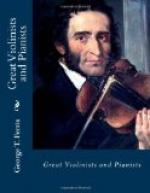Liszt remained at Weimar for ten years, when he resigned his place on account of certain narrow jealousies and opposition offered to his plans. Since 1859 he has lived at Weimar, Pesth, and Rome, always the center of a circle of pupils and admirers, and, though no longer occupying an active place in the world, full of unselfish devotion to the true interests of music and musicians. In 1868 he took minor orders in the Roman priesthood. Since his early youth Liszt had been the subject of strong paroxysms of religious feeling, which more than once had nearly carried him into monastic life, and thus his brilliant career would have been lost to the world and to art. After he had gained every reward that can be lavished on genius, and tasted to the very dregs the wine of human happiness, so far as that can come of a splendid prosperity and the adoration of the musical world for nearly half a century, a sudden revulsion seems to have recalled again to the surface that profound religious passion which the glory and pleasure of his busy life had never entirely suppressed. It was by no means astonishing to those who knew Liszt’s life best that he should have taken holy orders.
Abbe Liszt lives a portion of each year with the Prince-Cardinal Hohenlohe, in the well-known Villa d’Este, near Rome, a chateau with whose history much romance is interwoven. He is said to be very zealous in his religious devotions, and to spend much time in reading and composing. He rarely touches the piano, unless inspired by the presence of visitors whom he thoroughly likes, and even in such cases less for his own pleasure than for the gratification of his friends. Even his intimate friends would hardly venture to ask Liszt to play. His summer months are divided between Pesth and Weimar, where his advent always makes a glad commotion among the artistic circles of these respective cities. Of the various pupils who have been formed by Liszt, Hans von Bulow, who married his daughter Cosima, is the most distinguished, and shares with Rubenstein the honor of being the first of European pianists, now that Liszt has for so long a time withdrawn himself from the field of competition.
VI.
Liszt has been a very industrious and prolific writer, his works numbering thirty-one compositions for the orchestra; seven for the piano-forte and orchestra; two for piano and violin; nine for the organ; thirteen masses, psalms, and other sacred music; two oratorios; fifteen cantatas and chorals; sixty-three songs; and one hundred and seventy-nine works for the piano-forte proper. The bulk of these compositions, the most important of them at least, were produced in the first forty years of his life, and testify to enormous energy and capacity for work, as they came into being during his active period as a virtuoso. In addition to his musical works, Liszt has shown distinguished talent in letters, and his articles and pamphlets, notably the monographs on Robert Franz, Chopin, and the Music of the Gypsies, indicate that, had he not chosen to devote himself to music, he might have made himself an enviable name in literature.




